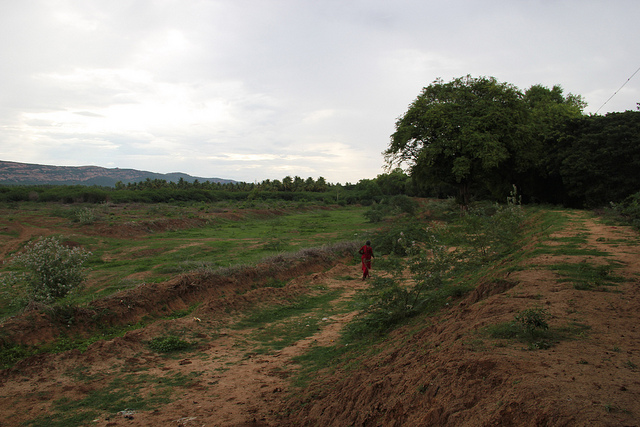
Madurai, Tamil Nadu's second largest city, is now filled with buildings and roads which are eating into its age old network of tanks and canals. This change did not happen overnight. It began in the late 19th century by the British when they merged several hamlets to establish their headquarters in the region.
In their paper Dying Tanks in Urban Areas: What can be done with them?, Seenivasan and Kanagavalli discuss the past, present and the possible future of tanks in the city of Madurai.
Tanks of Madurai
Tank irrigation is very common in south India. An extensive network of manmade tanks and irrigation channels commissioned by erstwhile kings and philanthropists dot the landscape. These tanks are either connected to a river or to other tanks in the area, forming an inter-connected cascade where the overflow from one tank is diverted into another downstream.
With the exception of a few private ones which are rarely seen within city limits, almost all other tanks in Tamilnadu are considered ‘government property’ and belong to the Land Revenue Department. Larger tanks that irrigate over 100 acres of land come under the control of the Public Works Department. All tanks part of the Vaigai system within Madurai fall under the purview of the PWD’s Irrigation Department.
Changing landscape
33 irrigation tanks and innumerable ponds dotted the townscape in the early 19th century. The real estate boom of the 90s witnessed the transformation of agricultural lands into housing plots. Between 1994 and 2011, the combined land area of agricultural fields and water bodies shrunk from 27.13 % to 11.95%.

By 2011, 14 of these tanks were no longer present while the rest are now plagued with problems. Close to a third of the habitations and civic structures in the city are built over dismantled tank beds, with construction still continuing unabated.
A survey of the existing tanks revealed many problems. Tank bunds were found to be dilapidated with supply channels encroached upon. Weirs and sluices were in dire need of repair. Dumping of construction debris and domestic waste was rampant. All of these factors resulted in the diminished water carrying capacity of the tanks, with many of them remaining empty for most of the year.
Water, water everywhere
Tanks are designed as cascading chains with forward and backward linkages. When a tank in the middle of the chain gets dismantled, the flow gets disrupted. For buildings in these spots, flooding and inundation during rainy months is something they have to live with. Also, the missing links in between affect the volume of water that passes from one tank to the other, affecting local agriculture and livelihoods.
It is quite surprising that several government institutions including a district court complex and the city’s central bus stand, are right on top of tank beds! And it's no surprise that when it rains, water from the surrounding areas finds its way into the bus stand which once was a tank, flooding the entire complex.
Tanks turn into sewage dumps
Rainwater that is collected and stored by tanks is one of the main sources of groundwater recharge in hard rock areas. When these tanks diminish, so does the magnitude of recharge. The Tamil Nadu Slum Clearance Board's statistics from 2011 show that over 15,000 households accommodating over 76,000 people lived on tank beds and channel beds alone. People here live precariously, dumping waste in drainage channels, risking floods.
Illegal slums aside, most of the legally constructed households discharge their domestic waste into the water channels due to the lack of proper connected sewerage facilities. Most of the tanks that have survived the test of time are now choked with domestic as well as industrial effluents.
While farmers wish to keep irrigation channels alive, the situation is not always in their favour. Many house owners fill up channels with debris to serve as footpaths or dispose sewage into them. Houses built on the fringes risk flooding when water levels reach the maximum carrying capacity of tanks.
Not too late for Madurai
Of the annual 91.27 MCu.m (million cubic metres) water requirement of the city, the corporation provides 32.67 MCu.m. The rest is met by private open wells and borewells. As groundwater becomes increasingly scarce, the Corporation is forced to look at alternatives such as recycling and treating used water to meet the ever-increasing demand. However, as of now, the city lacks the infrastructure to store the treated water.
But, it is not too late for Madurai. Tanks and related infrastructure make up for 4% of the city’s total area. If existing regulations are strictly applied and encroachments are removed, another 4% can be added to the tally.
- The responsibility of caring for tanks should be taken away from the revenue departments.
- Special administrative units should be set up to guide the rehabilitation process.
- All tanks and channels need to be re-surveyed to ensure equitable recovery.
- City Corporation should focus on connecting all households to a centralized sewerage network to prevent effluent outflow into drainage channels and eventually, the tanks.
Tanks should be recognized as prized resources; only then can their rehabilitation and upkeep be taken up in a sensible and judicious manner.
/articles/can-madurais-dying-tanks-be-revived